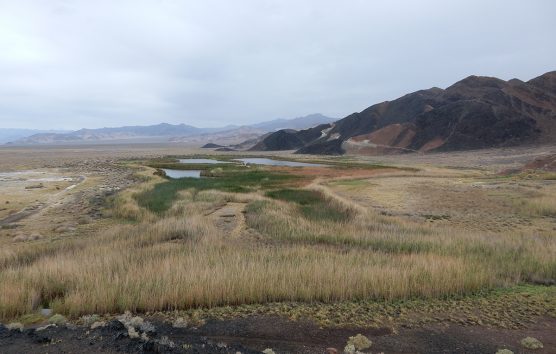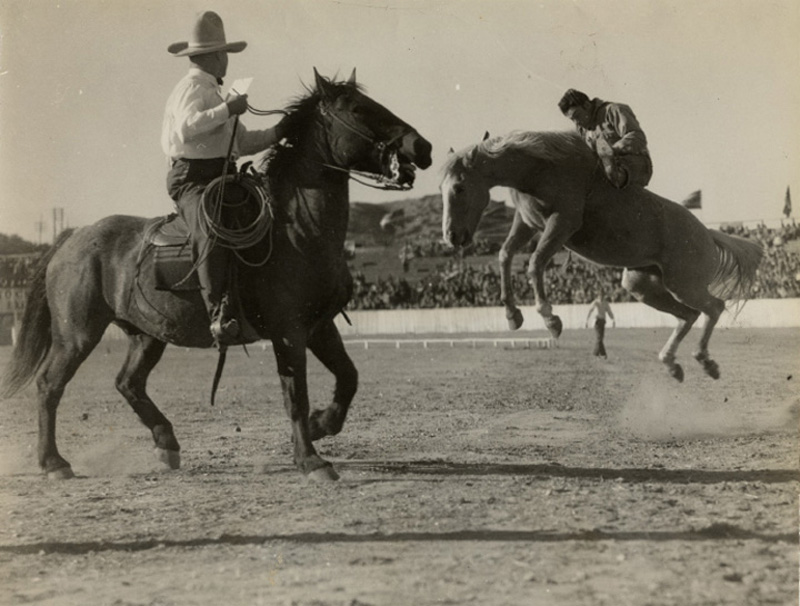 Most of us have watched Bugs Bunny cartoons where Bugs walks through the desert and sees a mirage. While the hot desert sun often creates the appearance of water where it does not actually exist, there are quite a few places throughout the Death Valley area that are real desert wetlands and not mere mirages.
Most of us have watched Bugs Bunny cartoons where Bugs walks through the desert and sees a mirage. While the hot desert sun often creates the appearance of water where it does not actually exist, there are quite a few places throughout the Death Valley area that are real desert wetlands and not mere mirages.
One such locale is Saratoga Springs, located in the Ibex Hills area of southeastern Death Valley National Park. This beautiful desert oasis consists of several springs that overflow into pools totaling about 6.5 acres, making the wetland the third largest marsh in the park.
This desert wetland supports numerous plants and animals. The Saratoga Springs pupfish is found here and nowhere else in the world. These fish are descendants of what was once a more generalized pupfish population that swam in the lakes that filled Death Valley thousands of years ago.
Several other invertebrate species can be found here, including the Amargosa spring snail. Migratory birds frequent the pools, making the area a favorite for bird watchers.
It is believed the springs were named after the resort town of Saratoga Springs, New York. The springs were an important water source for the 20-mule teams during the mining heyday of the late 1800s.
You can reach the springs by traveling on a graded dirt road, which leads to an overlook. The first sight of the wetlands will literally take your breath away and cause you to wonder, Am I really in Death Valley?
Another such area is Surprise Canyon, a lushly vegetated canyon in the Panamint Range. The upper half of the canyon is located in southwestern Death Valley National Park, while the lower half is on land managed by the Bureau of Land Management.

Surprise Canyon
Congress designated Surprise Canyon Wilderness as a wilderness area in 1994. The wilderness are shares its entire eastern border with Death Valley National Park. Small slopes gradually rise from the west into the jagged ridges and steep sides of the Panamint Range. Canyons cut deeply into the mountains to form the interior of the wilderness. Elevations climb from about 1,000 feet in the west to more than 7,000 feet in the east, providing fabulous vistas of the Panamint Valley from mountain summits.
Surprise Canyon’s riparian oasis is confined by glistening narrows. Cottonwoods and willows are found in the lower elevations, while forests of piñon and juniper are found at the higher elevations.
The canyon likely received its name from the “surprise” visitors experience when they visit the area and stumble upon the unexpected springs bubbling from the steep walls of Surprise Canyon. The springs feed a yearlong flow of water. The BLM has designated most of Surprise Canyon an “Area of Critical Environmental Concern” (ACEC) in order to protect vegetation and wildlife – including the rare Panamint alligator lizard – as well as historic and cultural resources.
Another example is the Amargosa River. Often called the “Crown Jewel of the Mojave Desert,” the Amargosa is the only free-flowing river in the Death Valley region of the Mojave, providing a rare and lush riparian area in the desert.
The Amargosa River originates around the hills surrounding Beatty, Nev., and travels through the Mojave Desert to Badwater in Death Valley National Park. Most of the water travels underground, but surface flow exists in the areas of Shoshone, Tecopa and Amargosa Canyon. Where the river runs on the desert surface, it creates a series of oases with running water, wetlands, lush vegetation, and even a waterfall in the canyon.

Amargosa River
The Amargosa Canyon Natural Area is located at the south end of Tecopa Valley and occupies the heart of the Tecopa Basin, east of the southeastern corner of Death Valley National Park. The BLM designated the area an ACEC to protect endangered plants and animals found there.
Congress also designated 26 miles of the Amargosa River – the stretch between Shoshone and Dumont Dunes – as a National Wild and Scenic River in 2009. With this designation, Congress can preserve rivers that possess outstandingly remarkable scenic, recreational, geologic, fish and wildlife, historic, cultural or other similar values. Rivers (or sections of rivers) so designated are preserved in their free-flowing condition and cannot be dammed or otherwise impeded.
Two hundred fifty different bird species have been observed in Amargosa Canyon, including least Bell’s vireo, the yellow-billed cuckoo and the great horned owl. The area is also known for its wide variety of bats and rodents, the most significant of which is the critically endangered Amargosa vole.
There are more springs, wetlands and oases throughout Death Valley. The ones I have mentioned are only a sampling of what Death Valley has to offer.
Consider visiting Death Valley and seeing some of them yourself. The best months to visit are March, April, October and November, when the temperatures tend to be moderate.
Linda Castro is a nature enthusiast and animal lover. She is the Desert Field Organizer for the California Wilderness Coalition and serves on the board of the SCV-based Community Hiking Club. Her commentaries relate to California’s deserts.
Like this:
Like Loading...
Related







 Tweet This
Tweet This Facebook
Facebook Digg This
Digg This Bookmark
Bookmark Stumble
Stumble RSS
RSS










































REAL NAMES ONLY: All posters must use their real individual or business name. This applies equally to Twitter account holders who use a nickname.
1 Comment
Where please tell me that place is great very nice